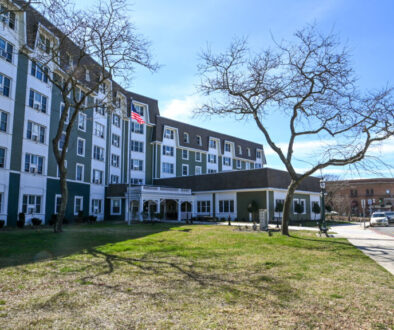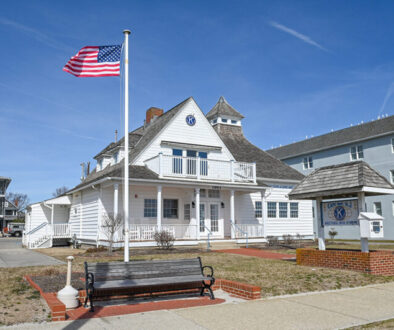The Longest Yarn: From D-Day to Cape May
yarn (noun):
1. A continuous, twisted strand of fibers used in knitting.
2. A narrative of adventure(s).
Few events in modern history have captured the imagination of so many as the famous Allied landings at the beaches of Normandy on June 6, 1944. One need only say the word “D-Day” and there is usually instant recognition, admiration, and awe. This hallowed date known by the world sparked the great but costly liberation of Europe from Nazi domination during the darkest days of World War II, in which thousands displayed some of the greatest feats of heroism and sacrifice recorded in the annals of warfare.
To this day, the campaign known as Operation Overlord fascinates millions. New volumes are published regularly, and popular documentaries and films such as The Longest Day,Saving Private Ryan, and Band of Brothers enjoy long standing critical and commercial success. In the face of this evergreen interest, however, there is the poignant reality that the number of surviving veterans and eyewitnesses is dwindling rapidly. In fact, June will mark the 80th anniversary of that day. Events to commemorate the significance of Overlord and to honor those who participated will, as in years past, take a wide variety of forms throughout Western Europe and France in particular.


Meanwhile, here on the southern tip of the Garden State, it is well known that the Cape May community played a robust role in contributing to the war effort. This included providing enlistment manpower to all theaters of operation, standing watch and manning gun emplacements at coastal defenses along the Atlantic shore and the Delaware Bay, and serving as a major base for East Coast naval aviation training.
Less well known, however, is that Cape May has direct, personal connections to the D-Day landings at Normandy. And one of the more noteworthy and fascinating of those connections is the story of iconic Cape May hotelier and restaurateur Harry Kulkowitz and his role in inspiring a particularly distinctive commemoration this year known as The Longest Yarn. We’ll come back to Harry.
Playing on the name of Cornelius Ryan’s bestselling book and the award-winning film The Longest Day, The Longest Yarn is the brainchild of Tansy Forster, a Brit who has lived the expatriate life in Houeville, Normandy for the last 20 years. Tansy, whose uncle was killed in the war, has long been an enthusiast for and participant in annual remembrances of the D-Day battles. She and her husband Mike for many years have opened their home as hosts, especially to veterans and D-Day participants, during the anniversary celebrations. In doing so they have drawn significant personal fulfillment from the moving experience of being with actual veterans and eyewitnesses in the very locations of such history.


Fueled with this enthusiasm, and with the 80th anniversary fast approaching, Tansy conceived the Longest Yarn project, an undertaking not only of considerable size but also in the scope of participation to create it. She proposed crafting a distinctive piece of art by envisioning an 80-meter long knitted and crocheted collection of three-dimensional dioramas, composed of 80 one-meter panels connected side-by-side. Each panel would depict a different scene or event occurring across the (you guessed it) 80 days between the D-Day landings and the liberation of the French capital of Paris.
The Longest Yarn was conceived to engage creative people skilled in this particular art form to memorialize this major human story of conquest, subjugation, resistance, and liberation. The knitted dioramas are also aimed at educating current and future generations by immersing them in a visual arts experience that is different from books and film. The project further serves a personal role in revitalizing Tansy’s spirit and desire to leave a legacy given the inexorable demographic challenges facing the Greatest Generation. Today, the Longest Yarn 3-D tapestry has gone from idea to reality thanks to the gifted hands of more than a thousand volunteers recruited across the globe including Australia, Canada, the UK, New Zealand, and mainland Europe. And yes, here in Cape May County. And what more of this local connection?
Well, as serendipity would have it, one of the D-Day veterans hosted multiple times in the Forster’s Normandy home across the last 20 years was none other than Cape May icon Harry Kulkowitz. Until his death in 2017 at age 92, Harry was well known as the founder and owner of the award-winning Mad Batter Restaurant and Carroll Villa Hotel on Jackson Street. It seems that virtually everyone in the region knew of Harry’s nearly 40 years as a hotelier and restaurant owner in the center of town. And though not a secret, far fewer knew his backstory, including his experiences during the war—that, for instance, he landed at Utah Beach on Day One of the invasion. Or, that he was a recipient of the Legion d’Honneur, the highest order of merit awarded by the government of France. Or that he was specifically highlighted by President Barack Obama during his official remarks at the 70th anniversary of the landings in 2014.

Harry Kulkowitz, a signalman in WWII, returned to Utah Beach ten years ago when this photo was taken. Photo courtesy of Mark Kulkowitz
Harry Kulkowitz was born in the Bronx, New York in 1924 to Russian Jewish immigrants. As a first generation American, he was not only imbued with a sense of patriotism when the U.S. came under attack at Pearl Harbor in December of 1941, but even as a young man he felt a sense of moral obligation to join the war effort in some fashion. He knew firsthand how his parents had themselves fled for the United States to escape the marginalization and antisemitism they had experienced in Eastern Europe. He believed the stakes for a free society, with Nazi Germany and Imperial Japan conquering most of Europe and the Far East, were too high not to do one’s part. But, to join the military at that time Harry would have to lie about his age. So, he did.
Kulkowitz enlisted in the U.S. Army six months before his 18th birthday. After initial basic training he was assigned further technical schooling to earn his military occupational specialty (MOS). He trained as a radioman but not just as a radio operator. His technical forte was in the interception of enemy radio signals. This, it turns out, was a military capability that effectively ensured him a place on the front lines. After some relatively routine duty stateside and in England, it was as a Technician 5th Grade with the 114th Radio Signals Intercept Company, 4th Infantry Division, that Kulkowitz found himself on a landing craft churning toward the heavily fortified shores of Normandy. His unit landed at Utah Beach. It was D-Day, June 6, 1944, and he was 19 years old.



Kulkowitz survived not only the landing and frightening scramble off the beach, but he made it through additional combat operations after the breakout across Western France. He was engaged in the Battle of the Bulge (December-January 1944-45), a massive counteroffensive by the German Army in the Ardennes Forest of Belgium. It was a counterattack that nearly succeeded. Of significant note, just the day prior to the main German assault that sparked the Battle of the Bulge, Kulkowitz and members of his unit intercepted radio signals indicating the likely beginning of that counteroffensive. And it is this key event that is memorialized in Panel 60 of the 80-panel Longest Yarn tapestry.
Now that the tapestry is largely completed, plans are being implemented to provide for its public display. The grand unveiling, skillfully negotiated by Tansy Forster with French officials, will be at the Notre Dame Cathedral in Carentan, France [not to be confused with the one in Paris] on May 28, 2024. It is expected to remain available for public viewing there until September. The project has attracted significant attention from world news media outlets, most notably the BBC, who released a video feature in late February. Demand to view the work is expected to be very high. The unusual nature of the craftwork, stitching and crotchet, and its attention to detail in representing 80 real events and persons, is seizing public interest. And closer to home, the display is heading to the Naval Air Station Wildwood Aviation Museum next spring.


Back in Cape May, the legacy of Harry Kulkowitz and the connection with friends in Normandy has been continued by his son Mark. Carrying the torch, Mark has for some time now been—along with his family—owners and operators of the Mad Batter and Carroll Villa Hotel. More recently they acquired the historic Merion Inn on Decatur Street and remodeled and repurposed it as the Cricket Club. Mark, himself a U.S. Army veteran, had accompanied his father Harry routinely in visiting Tansy and Mike Forster in Houeville over the years. After Harry’s death, Mark and family members continued their visits to Normandy.
And for the 80th Anniversary, that is where they will be again.
Beyond the obvious participation by his father, Mark explains why this era of history matters so much to him. “We have to understand. This was a war that was worth fighting. This was literally a fight for humanity. And it is a rare time when our country truly came together as a single force with a clear purpose, even though many soldiers had little to no knowledge of the places they’d be fighting. This is for my grandparents. It’s for my family, and of course my father. But it’s for our country too. We were united. We need to continue to tell this story.”


The Cape May community has also mobilized and joined forces with Tansy Forster to bring not just the spirit of the project but the actual Longest Yarn itself to the United States. Cape May native and area leader Liz Shay, who has been active in county governance for many years, as well as a key member of the organization Knitting for Peace, has taken on organizational leadership of the local effort. Working with Mark and with county officials, they have formed The Longest Yarn-Cape May County, a collaborative nonprofit to organize, raise funds, and ultimately to bring the tapestry across the Atlantic. Artisans with Knitting for Peace also pitched in by stitching thousands of colorful poppies, well known as remembrance flowers, to adorn the buildings of Carentan and Sainte Mere-Eglise this June.
The joint Normandy-Cape May collaboration also has big ideas for touring the Longest Yarn beyond France and New Jersey. Some of them include approaching the National World War II Museum in New Orleans as well as flying the project to the U.K. where it can edify visitors from the British Isles in various education and military settings as well.
There are many ways for those interested to get involved in supporting the Longest Yarn and commemorate the heroes of D-Day. To learn more, the following social media sites are good places to start!



